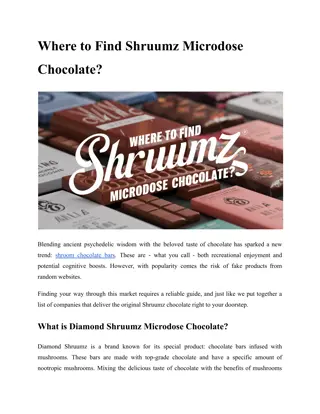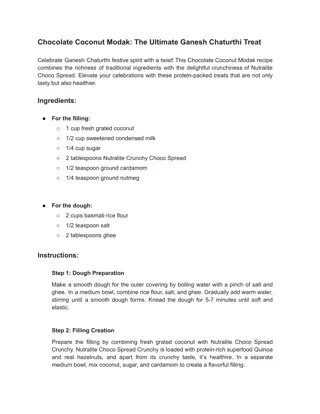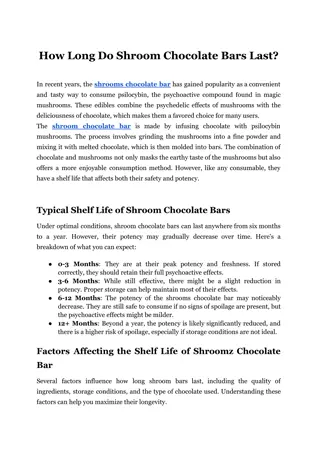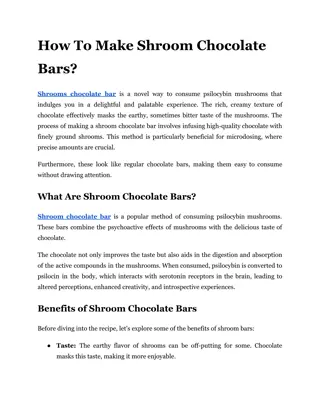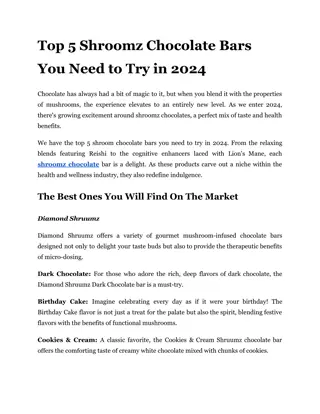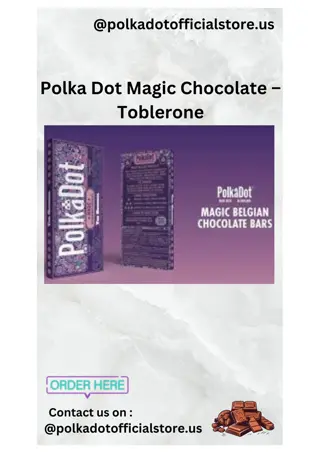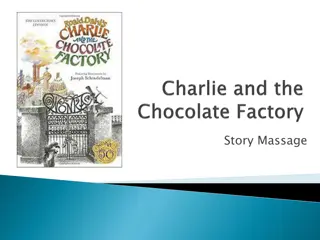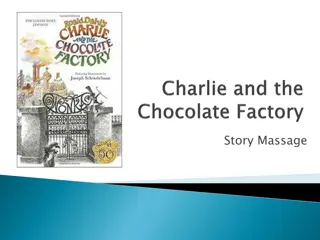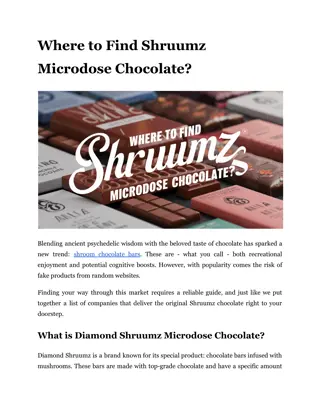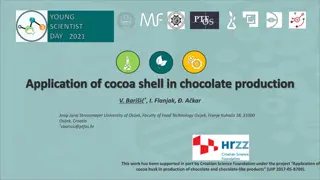All About Chocolate: From History to Legislation
Chocolate is a beloved treat with a rich history dating back centuries. From the earliest Mesoamerican consumption to modern-day regulations on cocoa products, explore the world of chocolates including types, FSSAI requirements, formulation, and more.
Download Presentation

Please find below an Image/Link to download the presentation.
The content on the website is provided AS IS for your information and personal use only. It may not be sold, licensed, or shared on other websites without obtaining consent from the author.If you encounter any issues during the download, it is possible that the publisher has removed the file from their server.
You are allowed to download the files provided on this website for personal or commercial use, subject to the condition that they are used lawfully. All files are the property of their respective owners.
The content on the website is provided AS IS for your information and personal use only. It may not be sold, licensed, or shared on other websites without obtaining consent from the author.
E N D
Presentation Transcript
CHOCOLATES Department : Dairy Technology Course Title : Food Technology I Course No. : DTT -322 Course Teacher: Bipin Kumar Singh
Introduction Chocolate is a preparation of roasted and ground cacao seeds that is made in the form of a liquid, paste, or in a block, which may also be used as a flavoring ingredient in other foods. The earliest signs of use are associated with Olmec sites suggesting consumption of chocolate beverages, dating from 19 centuries BCE. The majority of Mesoamerican people made chocolate beverages, including the Maya and Aztecs. The word chocolate is derived from the Spanish word chocolate, deriving in turn fromtheClassical Nahuatl wordxocol tl. Chocolate means a homogeneous product obtained by an adequate process of manufacture from a mixture of one or more of the ingredients, namely, cocoa beans, cocoa nib, cocoa mass, cocoa press cake and cocoa dust (cocoa fines/powder), including fat reduced cocoa powder with or without addition of sugars, cocoa butter, milk solids including milk fat. The chocolates shall notcontain any vegetable fat other than cocoa butter. Types of Chocolate Plain chocolate Milk chocolate Milk covering chocolate White chocolate Filled chocolate Composite chocolate
FSSAI Requirements for Chocolate Milk chocolates is obtained from one or more of cocoa nib, cocoa mass, cocoa press cake, cocoa powder includinglow-fat cocoa powder,with sugarand milksolids,includingmilkfat and cocoa butter. MilkCoveringChocolate isas defined above, butsuitable for covering purposes. Plain Chocolate is obtained from one or more of cocoa nib, cocoa mass, cocoa press cake, cocoa powder includinglow fat cocoa powder,with sugarand cocoa butter. PlainCoveringChocolate issame as that of plainchocolate but suitable for covering purposes. BlendedChocolate means the blendof milkand plainchocolates invarying proportions. White chocolate isobtained from cocoa butter, milksolids,includingmilkfat and sugar. Filled Chocolates means a product having an external coating of chocolate with a centre clearly distinct through its composition from the external coating, but does not include flour confectionery pastry and biscuitproducts. Composite Chocolate means a product containing at least 60.0 % of chocolate by weight and edible wholesome substances suchas fruits,nuts. Packing:Bulk chocolates shall be packed in clean, sound and odour-free containers made of tin-plate, plastic,greaseproofpaper,aluminiumfoil,cellulosefilmorother suitable flexiblepackagingmaterials.
Other Versions of Chocolate Products Unsweetened chocolate Dark chocolate Milk chocolate Baking chocolate Couverture
Legislation of Cocoa Products Most EEC and USA, the name chocolate may only be used if no other fat is present but cocoa butter. Cocoa butter equivalent fats, up to 5.0% of the total chocolate content may be used in UK, Ireland, Denmark and Sweden. Formulation for Some Types of Chocolate Types of chocolate Cocoa mass,% Cocoa butter,% Milk powder,% Sugar, % Dark chocolate 40 10 - 50 Milk chocolate 10 20 15 55 Enrobing chocolate 40 15 - 45 White chocolat - 25 25 50
Ingredients in Chocolate Milk solids Milk crumb Butter Oil Cocoa butter Sugar Purpose of using sugar (a) Stabilization of product (b) Reduced bacterial growth and possibility of lipolytic rancidity (c) Uniform flavour to product (d) Balances some of the bitter taste of cocoa
Contd Emulsifiers Lecithin Advantages (a) Prevents fat bloom. (b) Lowers viscosity of chocolate mass by reducing its surface tension. (c) Fixes the flavour and essential oils into product. (d) Exerts an antioxidant effect. Sorbitan mono-stearate Advantages (a) Prevents fat bloom. (b) Forms a layer on starch, sugar and fibre. Flavourings
Production of Chocolate Mixing of ingredients Refining Conching Objectives:The objective of conching are asfollows: Conversion of powdery, crumbly refined product into a flowable suspension of sugar,cocoa andmilk powder particles in a liquid phase of cocoa butter. (b)Allows the chocolate masstobe further mixed. (c) Removes the undesirable flavour while developing the pleasant ones; bitterness is reduced, perhaps allowing other flavournotes tobe more pronounced. (d) Develops amellow chocolate with asmooth mouthfeel. (e) Develops the flow properties aswell asflavour bycoatingthe new surface with fat.
Contd.. Type of Conches Batch Conches (i) Longitudinal conches, (ii) Rotary (round) conches. Continuous Conches. Phases in conching process Dry phase Pasty phase Liquid phase Effect of conching:In the Conche, the water content of chocolate masse is lowered from ~ 1.6% to 0.6-0.8%. As the moisture is removed, it takes with it many unwanted flavourcomponents. In this way approximately 30% of short chain volatile fatty acids (viz., acetic acid) and up to 50% of low-boiling aldehydes are volatilized. Such removal of volatilized acid component is necessary to give the finished chocolate a full rounded flavour. Variables affecting conching Temperature Time of conching Size of particles
Contd Cooling and Tempering Objectives of cooling and tempering To develop a sufficient number of seed crystals to encourage the total fat phase to crystallize in a more stable polymorphic form. This in turn, will produce a better overall contraction and a more stable product.Temper is the induced partial pre-crystallizaiton of cocoa butter. Tempering, in general, involves reducing the temperature of the chocolate to induce crystallization of both stable and unstable polymorphs. The temperature is subsequently raised to a point where the unstable polymorphs melt, leaving only polymorphically stable crystals which can then seed the crystallization ofthebulk chocolatein a stablepolymorphicform
Contd Polymorphism of cocoa fat Tempering process The tempering steps include the following: 1. Complete melting 2. Cooling to the point of crystallization 3. Crystallization 4. Melting out of unstable crystals Moulding and Enrobing Moulding Enrobing Cooling Packaging
Contd Storage and shelf life Sugar and Fat Bloom in chocolates Sugar bloom:Storage of chocolates in damp conditions Method to minimize sugar bloom:Maintain an appropriate storage temperature (< 20oC) for chocolate products. Fat bloom:fat bloom in chocolate is the cocoa butter that has separated toward the surface. Methods to minimize fat bloom:Maintain an appropriate storage temperature (< 20oC) for chocolate products
Uses of Chocolate Chocolate can be consumed as such. Much used as an ingredient on or in other foodstuffs e.g. enrobing of biscuits. Chocolate drops go into biscuits. Chocolate used in between wafers. Chocolate is a popular flavour for desserts, ice cram, cakes, etc. In UK, milk chocolate with typical crumb caramel note is predominant





